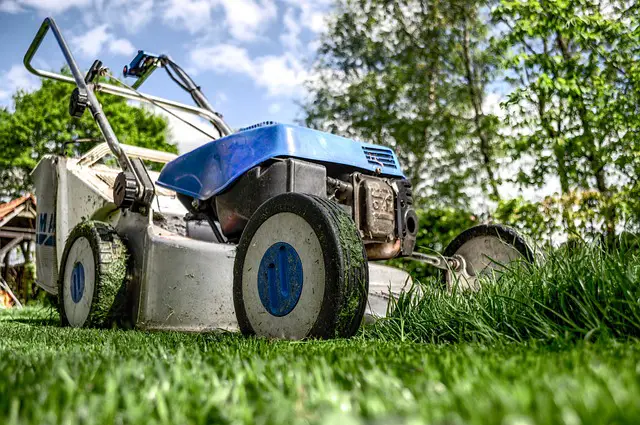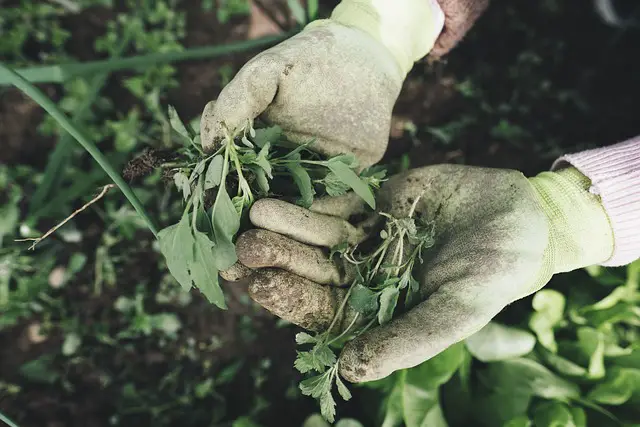Grass is cultivated plants with value, while weeds are unwanted, invasive plants that disrupt gardens and landscapes.
TL:DR Grass Vs. Weeds
Grass refers to a group of plants with specific characteristics and growth habits that make them desirable for lawns. There are various types of grass, each with its own unique features and benefits.
Weeds are unwanted plants that tend to grow aggressively and can overrun a lawn if not properly controlled.
What is Grass?

Grass, a ubiquitous element of the natural landscape, holds within it fascinating characteristics and a multitude of variations. Discovering the essence of what truly constitutes grass unveils a realm of intriguing botanic intricacies. Delving into the characteristics of grass and exploring the diverse types that exist allows us to unravel the tapestry of this pervasive plant life. Get ready to embark on a journey that unveils the wonders and diversity of this verdant wonder of nature.
Characteristics of Grass
- Grass is a type of plant that belongs to the Poaceae family.
- It has long, narrow leaves that are arranged alternately along the stem.
- Grass usually has a fibrous root system, which helps it to absorb water and nutrients from the soil.
- Most grass species have the ability to grow in various climates and soil types.
- Grass plants produce flowers and seeds, which are essential for reproduction.
- Grass can grow in dense formations, covering large areas of land.
- It is known for its rapid growth rate compared to other plants.
- Grass is able to withstand grazing and mowing due to its ability to regrow quickly.
- It provides a soft, cushiony surface that is suitable for activities such as sports and recreational activities.
- Grass plays a significant role in the ecosystem by preventing soil erosion and providing habitats for various insects and animals.
- It also contributes to the oxygen production and carbon dioxide absorption cycle.
Types of Grass
Below is a table showcasing different types of grass:
| Type | Characteristics |
| Bermuda Grass | Drought-tolerant, fast-growing, often used on sports fields |
| Zoysia Grass | Tolerant to heat and cold, low maintenance, dense and compact growth |
| Fescue Grass | Adaptable to various climates, shade-tolerant, requires less watering |
| St. Augustine Grass | Tolerant to warm climates, lush and dense, quick recovery from damage |
| Kentucky Bluegrass | Thrives in cool-season regions, fine texture, high wear resistance |
Each type of grass has its own unique characteristics and suits different environments and needs. For example, Bermuda Grass is popular for its ability to withstand heavy foot traffic, making it ideal for sports fields. Zoysia Grass, on the other hand, is known for its ability to thrive in both hot and cold climates and requires less maintenance.
It’s important to understand the characteristics of different grass types to choose the right one for your lawn. So before making a decision, consider factors like climate, sun exposure, foot traffic, and maintenance requirements.
Fact: Did you know that Kentucky Bluegrass is used in many golf courses due to its fine texture and ability to withstand wear and tear?
What are Weeds?

Weeds – those pesky invaders that disrupt the tranquility of our gardens. In this section, we’ll dig deep into the world of weeds and uncover their true nature. From the distinct characteristics that set them apart to the various types lurking in our lawns, we’ll explore the fascinating realm of weeds. Prepare to be amazed by the resilience and adaptability of these unwelcome guests as we dive into what makes them so different from our beloved grass.
Characteristics of Weeds
- Weeds are unwanted plants that possess the characteristics of being fast-growing, competitive, and having a wide variety.
- These characteristics make weeds adaptive to various environmental conditions, such as poor soil quality and different climate conditions.
- Due to their persistent nature, weeds can be difficult to eradicate and often require ongoing management and control measures.
- One of the key characteristics of weeds is their reproductive efficiency, allowing them to produce large quantities of seeds for survival and spread.
- Some weeds are classified as invasive species, leading to ecological damage as they outcompete and displace native plants.
- Weeds are also resilient, able to bounce back and regrow even after being cut or removed.
- In addition to their negative impact on the aesthetic appearance of landscapes and gardens, weeds can also reduce the productivity of agricultural crops.
Types of Weeds
Here is a table listing the types of weeds:
| Type of Weed | Description |
| Dandelion | A common weed with yellow flowers and fluffy seed heads |
| Crabgrass | A spreading annual grassy weed that often invades lawns |
| Bindweed | A vine-like weed with white or pink trumpet-shaped flowers |
| Chickweed | A small-leaved weed with white star-shaped flowers |
| Clover | A low-growing weed with three-parted leaves and white or pink flowers |
| Nettle | A weed with stinging hairs on the leaves and stems |
| Purslane | A succulent weed with thick, fleshy leaves |
| Thistle | A spiny weed with purple or pink flowers and prickly leaves |
| Plantain | A broad-leaved weed with long stalks and small green flowers |
| Quackgrass | A perennial grassy weed with creeping rhizomes |
These are just a few examples of the many types of weeds that can be found in lawns and gardens. It’s important to identify and manage weeds to maintain the health and appearance of your yard or landscape. Proper weed control practices, such as regular mowing, hand-pulling, or using herbicides, can help keep weeds from taking over.
Differences Between Grass and Weeds
When it comes to grass and weeds, there are some evident differences that go beyond mere appearances. In this section, we’ll dive into the contrasting characteristics and behaviors of these plants. From their growth habits to their ecological impact, we’ll uncover the distinct features that set grass and weeds apart. We’ll explore the purposes and benefits of both, along with effective ways to control and manage them. Get ready to gain a deeper understanding of these green wonders and nuisances!
1. Appearance and Growth Habits
| Aspect | Grass | Weeds |
| Appearance | Grass exhibits slender and cylindrical stems with blades that are usually flat and narrow. It grows in a dense and even manner, forming a uniform layer. | Weeds have various appearances, but they often have thicker stems with irregular growth patterns. They can be bushy, spiky, or have creeping vines. |
| Growth Habits | Grass typically grows in a horizontal manner and spreads through stolons (above-ground runners) or rhizomes (underground stems). It forms a well-established root system. | Weeds have aggressive growth habits and can quickly invade and dominate an area. They may spread through seeds, underground roots, or by producing many offspring. |
2. Purpose and Benefits
The purpose and benefits of grass and weeds are different. Here are some key points to consider:
- Grass:
- Provides a lush and green landscape for aesthetic appeal.
- Creates a soft and comfortable surface for recreational activities.
- Absorbs rainfall and helps with water filtration and runoff prevention.
- Produces oxygen and helps in reducing carbon dioxide levels.
- Stabilizes soil and prevents erosion.
- Offers habitat and food for various insects, birds, and small animals.
- Weeds:
- Can indicate soil conditions and offer clues about the state of the environment.
- Some weeds have medicinal properties and can be used in herbal remedies.
- Provide nectar and pollen for bees and other pollinators.
- Some weed species can help improve soil fertility by accumulating nutrients.
- Act as cover crops to prevent soil erosion and suppress the growth of more invasive plants.
- Can be utilized as a food source for humans and animals in certain cases.
Throughout history, grass has played a vital role in human civilization. It has been used for grazing livestock, providing food sources, and is often referenced in literature and poetry. Weeds, on the other hand, have been viewed as nuisances or invasives. As our understanding of ecosystems and biodiversity grows, we are starting to recognize the value and benefits that certain weeds bring to the environment.
3. Ecological Impact
The ecological impact of grass and weeds can vary significantly. Here is a table illustrating the ecological impact of these plants:
| Aspect | Grass | Weeds |
| 1. Biodiversity | Grass lawns often provide limited habitat for wildlife due to their monoculture nature. | Weeds can support biodiversity by providing food and shelter for insects, birds, and other wildlife. |
| 2. Soil Health | Grass lawns can help prevent erosion and improve soil structure. | Weeds can indicate soil health issues such as nutrient deficiencies or compaction. |
| 3. Water Usage | Grass lawns require regular watering, contributing to water consumption. | Weeds can compete with other plants for water, reducing available resources. |
| 4. Pesticide Use | Grass lawns often require pesticides and herbicides to control pests and invasive species. | Weeds can become resistant to pesticides but their presence can also indicate the need for natural pest control methods. |
To effectively manage the ecological impact of grass and weeds, it is important to consider alternatives to traditional lawns, such as native plant gardens or natural meadows. These options can promote biodiversity, reduce water usage, and minimize the need for pesticides. Practicing integrated pest management techniques can help control weeds without harming the environment. By understanding the ecological impact and making informed choices, we can create landscapes that are both aesthetically pleasing and environmentally sustainable.
4. Controlling and Managing
To effectively control and manage grass and weeds, consider the following steps:
- Mowing: Regularly mow your lawn to maintain a desirable grass height and discourage weed growth. Ensure you remove no more than one-third of the grass height in a single mowing session.
- Weed removal: In order to prevent weeds from spreading and competing with the grass, manually identify and pull them out from the root in your lawn.
- Avoid overwatering: To promote strong grass roots and prevent weed growth, it is essential to avoid overwatering. Grass typically requires about 1 inch of water per week, so water deeply and infrequently.
- Fertilization: Properly fertilize your lawn to keep the grass healthy and vibrant. Choose a balanced fertilizer that provides essential nutrients without encouraging excessive weed growth.
- Aeration: Improve water and nutrient absorption and reduce weed encroachment by periodically aerating your lawn to alleviate soil compaction. This will ultimately enhance the health of your grass.
- Pre-emergent herbicides: Prevent the growth of weed seeds by applying pre-emergent herbicides before germination. Carefully follow the instructions and apply the herbicide at the recommended time for maximum effectiveness.
- Post-emergent herbicides: If weeds are already present, use post-emergent herbicides to specifically target and control them. Take caution to avoid damaging the desired grass while applying these herbicides.
- Maintenance: Regularly inspect your lawn for any signs of weed growth or problems with the grass. Address them promptly to prevent further spread and maintain a healthy, weed-free lawn.
By following these steps, you can effectively control and manage grass and weed growth in your lawn, ensuring the health and beauty of your outdoor space.
How to Differentiate Grass from Weeds?
If you’ve ever wondered how to tell the difference between grass and weeds, you’ve come to the right place! In this section, we’ll explore ways to easily differentiate these green beauties. From examining leaf characteristics to studying growth patterns, flowering and reproduction, and even the way they respond to lawn care practices, we’ll equip you with the knowledge to identify and distinguish grass from those pesky weeds. Get ready to become a master of lawn botany!</>
1. Leaf Characteristics
Here is a table highlighting the leaf characteristics of grass and weeds:
| Leaf Characteristics | Grass | Weeds |
| 1. Shape | Narrow, blade-like shape | Varies – can be lance-shaped, oval, heart-shaped, or other. |
| 2. Veins | Parallel veins running the length of the leaf | Varies – veins may be parallel or netted. |
| 3. Margins | Smooth margins | Varies – margins may be smooth, lobed, serrated, or toothed. |
| 4. Color | Typically green | Varies – can be green, red, purple, or other. |
| 5. Growth Pattern | Uniform, upright growth | Varies – growth may be upright or sprawling. |
These leaf characteristics can help differentiate between grass and weeds. Grass typically has narrow, blade-like leaves with parallel veins and smooth margins. It is usually green in color and grows in a uniform, upright pattern. On the other hand, weeds can have a variety of leaf shapes, vein patterns, margin types, and colors. Weeds may also exhibit different growth patterns, ranging from upright to sprawling.
2. Growth Patterns
Growth patterns of grass and weeds can be identified by observing certain characteristics. Here is a table summarizing the growth patterns of grass and weeds:
| Grass | Weeds | |
|---|---|---|
| Height | Varies depending on the species | Varies depending on the species |
| Stem | Erect and upright | May be upright, creeping, or climbing |
| Leaves | Narrow and elongated | Varies in shape and size |
| Shoots | Develop from the base | May develop from seeds or rhizomes |
Grass generally grows upright with narrow and elongated leaves. It develops shoots from the base and can vary in height depending on the species. Weeds, on the other hand, exhibit more diversity in growth patterns. They can have upright, creeping, or climbing stems. Their leaves can vary in shape and size, and they may develop from seeds or rhizomes.
Understanding the growth patterns of grass and weeds is important for proper identification and management. By recognizing these differences, you can effectively control undesirable weeds and cultivate a healthy lawn or garden. It is essential to regularly monitor and assess the growth patterns to maintain the desired vegetation and prevent the spread of weeds.
3. Flowering and Reproduction
Flowering and reproduction play vital roles in distinguishing between grass and weeds.
- Flowering: Grass plants typically have inconspicuous flowers that lack showiness or vibrant colors. They bear small, clustered flowers known as florets, primarily wind-pollinated. On the contrary, weeds might produce attractive and vivid flowers that attract pollinators like bees and butterflies.
- Reproduction: Grasses primarily reproduce through seed dispersal. They generate plentiful lightweight seeds that can be easily carried by the wind. Weeds, however, employ various reproduction methods, including both seed production and vegetative propagation. Some weeds can spread rapidly through underground rhizomes or stolons, enabling them to rapidly cover an area.
- Grass seed production: Grasses aim to produce a substantial quantity of seeds for successful reproduction. In a single growing season, a lone grass plant can generate thousands of seeds. On the other hand, weeds may produce fewer seeds but possess a high germination rate, allowing for rapid establishment and spread.
- Weed seed dispersal: Weeds often possess specific adaptations for seed dispersal, such as hooks or barbs that attach to animal fur or clothing, facilitating transportation to new locations. Some weeds also produce seeds capable of remaining dormant in the soil for several years, awaiting favorable conditions for germination.
4. Response to Lawn Care Practices
When it comes to the response of grass and weeds to lawn care practices, understanding their behavior is crucial. There are several factors to consider for achieving a lush lawn:
- Mowing: Regular mowing plays a vital role in maintaining the health and appearance of grass, as it promotes thicker growth. However, it’s important to note that weeds may respond to mowing in different ways. Some weeds spread their seeds, while others regrow from the remaining roots after being cut.
- Watering: Consistent watering is essential for keeping the grass green and healthy. On the other hand, weeds tend to have better survival capabilities in dry conditions. Deep watering is particularly beneficial for encouraging the growth of grass roots, making them more resilient.
- Fertilizing: Properly fertilizing the grass can provide a boost to its growth and greenness. Unfortunately, weeds can also take advantage of the added nutrients, growing faster and competing with the grass for resources.
- Weed control: Managing weed growth can be achieved through different methods. Applying herbicides or manually removing weeds can help keep them in check. It’s important to note that grass is generally more tolerant of selective herbicides, while weeds may require specific treatments to be effectively controlled.
| What's the Difference Between Grass And Weeds" |
|---|
| Weeds and grasses are not the same. Weeds are unwanted plants that can be unsightly, obstructive, and irritating. (Source: mb.com.ph) |
| Broadleaf weeds are easy to identify as they are large and can resemble flowers. Examples include dandelions, henbit, and clovers. (Source: chorbie.com) |
| Grasses belong to the Poaceae family and have long narrow leaves, hollow stems, and parallel leaf venation. They can become weeds when they grow in unwanted places. (Source: mb.com.ph) |
| Grasses can be invasive and hard to remove due to their long-lasting seeds. Weeds, on the other hand, only exist in places where there are human activities. (Source: chorbie.com) |
| A well-kept lawn can increase the value of a home by up to 10%. Grass not only serves as a food source but also cools the surroundings and improves air quality. (Source: evergreenturf.com) |
Frequently Asked Questions
What’s the difference between grass and weeds?
Grass and weeds are different in several ways. While grass is a specific category of plants belonging to the Poaceae family, weeds are unwanted plants that can grow in any area. Weeds can be either broadleaf or grassy, while grass has tender green stems and is cultivated for lawns and as ornamental plants.
How do you identify broadleaf weeds and grassy weeds?
Broadleaf weeds are easy to identify as they are large and can resemble flowers. Some examples include dandelions, henbit, and clovers. On the other hand, grassy weeds can be harder to spot as they resemble grass. They have blade-like leaves and net-like veins.
How can I remove grassy weeds from my lawn?
To remove grassy weeds from your lawn, you should follow a three-step process. First, apply a pre-emergent to the lawn to prevent grassy weeds from spreading thousands of seeds. Second, apply post-emergent to the visible weeds once the ground temperature is warm enough for the chemicals to be effective. Finally, encourage the growth of the desired grass by watering properly, mowing at the right height, and feeding regularly.
Are grasses always considered weeds?
No, not all grasses are considered weeds. Grasses belong to the Poaceae family and include important crop species like rice, wheat, and bamboo. They are cultivated for human and animal consumption. Grasses only become weeds when they grow in unwanted places.
What are some fun facts about grass?
Grass has several interesting facts. There are over 10,000 species of grass, and a well-kept lawn can increase the value of a home by up to 10%. Grass cools the surroundings and improves air quality. Additionally, it is an important part of the plant kingdom, serving as an ornamental crop and providing food and habitat for animals.
How can Chorbie experts help with weed and grass management?
If you’re unsure about the type of grass or how to deal with weeds in your lawn, Chorbie experts are available to provide guidance and assistance. They can help you identify the weeds, recommend effective treatments, and offer expert advice on maintaining a healthy and weed-free lawn.
Image Credits
Featured Image By – Gerd Altmann from Pixabay
Image 1 By – Rudy and Peter Skitterians from Pixabay
Image 2 By – AC works Co., Ltd. from Pixabay









